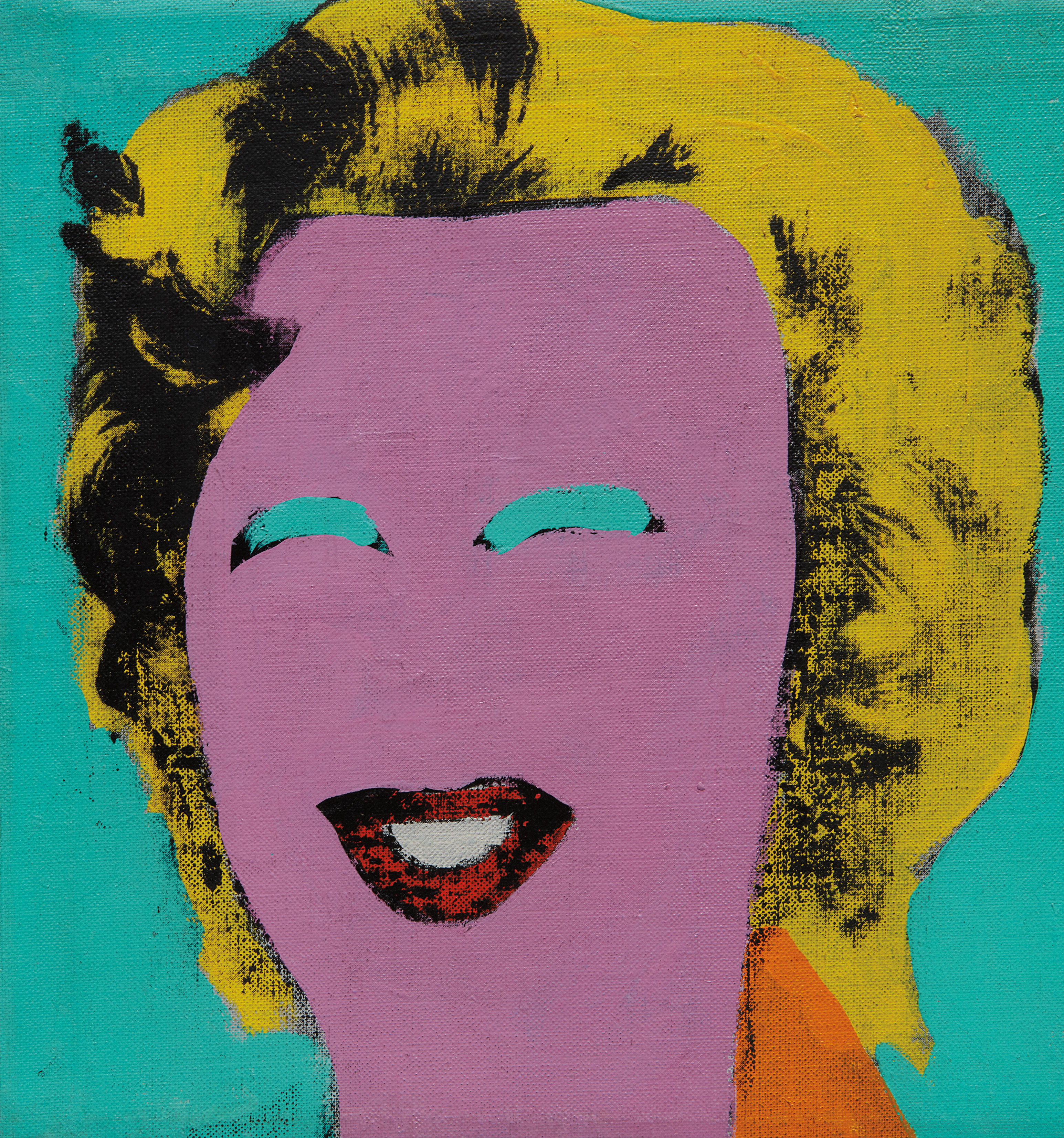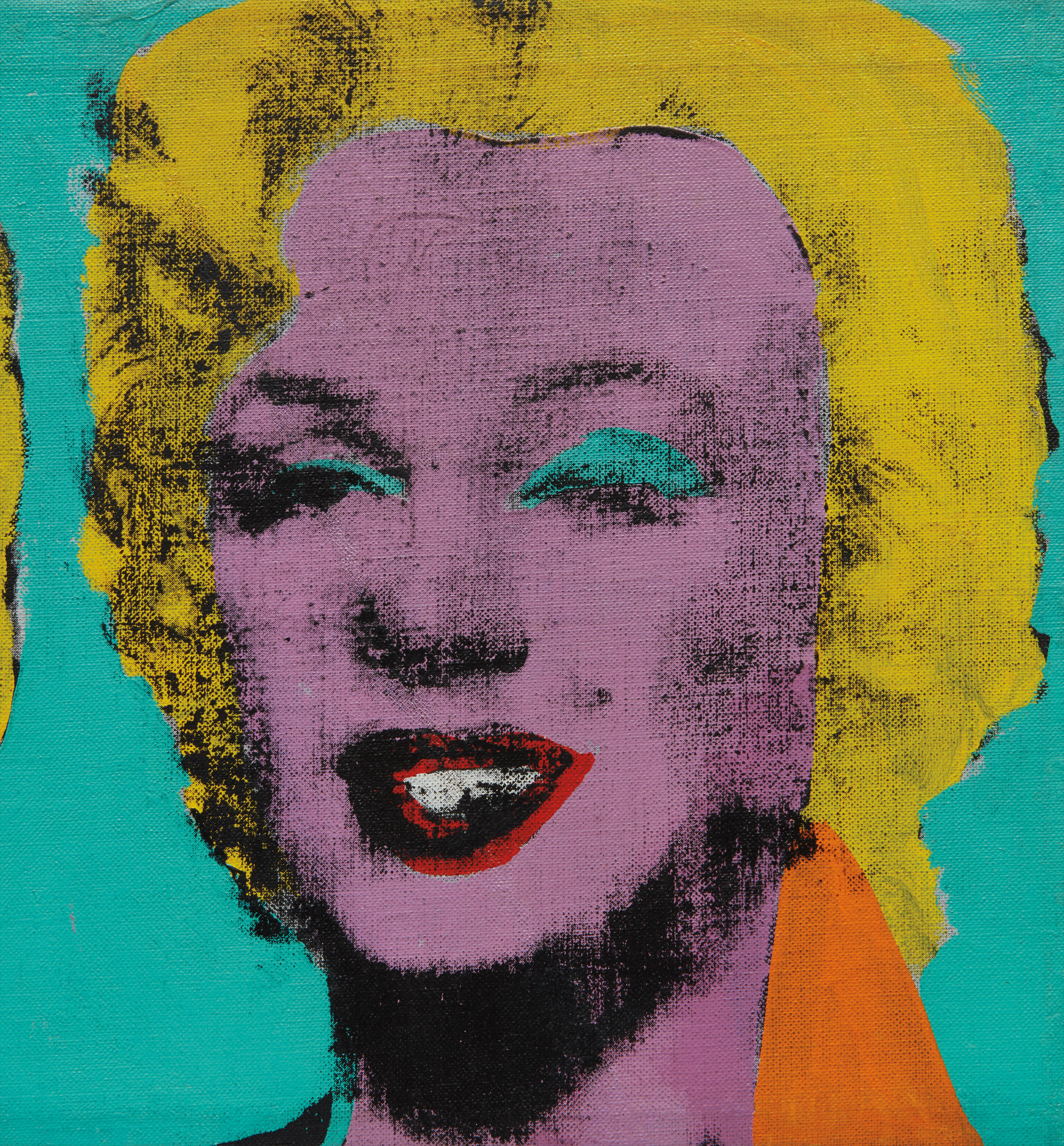





32Ο◆
Andy Warhol
Two Marilyns
Full-Cataloguing
Coming from the Warhola Family, who was gifted the work by the artist in 1962, Andy Warhol’s Two Marilyns is a powerful example from the first Marilyns series that the artist conceived in the immediate aftermath of the icon’s untimely death that summer. Employing his signature strategy of doubling, Warhol in the present work starkly contrasts the full facial portrait of Marilyn Monroe on the right, with a mask-like version of the icon’s visage on the left. Perfectly evidencing the sense of spontaneity and risk that the silkscreen technique introduced into his formal repertoire, this rare rendition of Marilyn uniquely sees Warhol abstract the female figure in a manner that pays homage to the great lineage of Pierre Bonnard, Pablo Picasso and Henri Matisse. Pursuing a similar distillation of form, color, and line, Warhol, with a playful nod to his Pop Art contemporary Tom Wesselmann as well as his own Comic Strip Paintings, obfuscates the silkscreened face with flat, planar areas of paint in a manner that emphasizes precisely those fragmented features that defined Monroe’s status as a sex symbol. Two Marilyns clearly holds a unique position within his oeuvre.
This series of Marilyns coincided with Warhol’s first foray into the photo-silkscreening process, a technique that he was the first to pioneer in art. In early 1962, Warhol was still using screens made with hand-cut stencils to create compositions that played on notions of multiplicity and seriality. Yet by that summer, he discovered that silkscreens could be produced from black-and-white glossy photographs. Although Warhol had used photo-screens of Troy Donahue and Warren Beatty for earlier portraits, it was the death of Marilyn Monroe that initiated Warhol’s full adaptation of this printing technique into his practice. It was on the morning Warhol’s 34th birthday on August 6, 1962 that news of Monroe’s suicide from the day before spread suggesting a more harrowing side of the glamorous star than Monroe’s crafted public persona had portrayed. The event instigated an inflection point in Warhol’s career, representing the coalescence of the artist’s fascination with celebrity and death as well as the introduction of the silkscreening process that enabled him to situate his interest in appropriation, repetition and seriality in parallel with mechanical processes of reproduction.
Warhol created three distinct Marilyn series during the 1960s: the Marilyns from 1962, which the present work is exemplary of; a group of five 40 by 40 inch paintings in 1964; and a portfolio of editioned works in 1967. All of these were based on the same source image of the widely circulated 8 by 10 inch glossy black and white photograph taken by Gene Korman for the promotion of the 1953 film Niagara that Warhol variously cropped. For the 1962 series of Marilyns, Warhol cropped the photograph where the neck meets the shoulders, just below the shadow cast by the jaw and chin. Warhol had two different sized screens made of this cropped image, one appropriate for 20 by 16 inch canvases, and another of approximately 15 by 11 inches that he used for serial compositions such as the present work. Of the fewer than 20 known serial Marilyn compositions from 1962, Warhol created a discrete group of six Two Marilyns – within which the present work takes a wholly unique position for the overpainting of the face on the left.
Warhol created Two Marilyns during a concentrated period of working on the overall series between August and September 1962 from Warhol’s Upper East Side home studio. Enthused by the possibilities of the silkscreening method, one that produced no two identical canvases despite utilizing the same mode of facture, Warhol screened multiple Marilyns at the same time – executing one after the other on a large linen canvas rolled out on the parquet floor. It was only later that he would subsequently cut them in single or multiple orientations.
Perhaps no other work from the entire Marilyns series than the present one reveals the extraordinary technique behind the jigsaw like constellation of color that correlates to isolated parts of the icon’s visage – the red lips and yellow hair, the turquoise eyeshadow, the various shades of the upturned collar. In this early Marilyn series, along with Troy and Liz both from 1962, Warhol printed a preliminary impression of the screen for positioning. These ghostly black outlines served as an indicator of where broader swathes of color should sit and could be painted over. A second and final impression was made over the paint, sandwiching the color between two black screens – giving the subject its particular definition. Warhol’s decision to repaint a mask of acra-violet on top of the left-side portrait in Two Marilyns brilliantly draws attention to the artifice of image making. Devoid of any illusion, the viewer is shown how the image is wholly constructed – just as Monroe’s own larger than life public persona was carefully crafted.
In Two Marilyns, Warhol has repeated his chosen image in an arrangement reminiscent of single film strip frames, a compositional choice that reflects the artist’s burgeoning interest in film at the time. Two Marilyns would seem to anticipate many of the same preoccupations the Screen Tests from 1964 and 1966 would interrogate, namely the focus on the process of a figure becoming an image. The doubling of images in the present work powerfully draws attention to those features that point to Monroe’s sanitized public persona as sex symbol: the full, darkened lips, the lightened hair, the manicured arch of her eyebrow. With Two Marilyns, Warhol begins his reduction of Monroe to her most salient features, an interrogation that he would take one step further with Marilyn’s Lips, 1962, Hirshhorn Museum and Sculpture Garden, Washington D.C. It is arguably only in these two works from his entire series of permutations of Marilyns that Warhol succeeds in separating the fragment from the whole, extracting those salient features of her face, and reducing them, as Georg Frei and Neil Printz note, to “a synecdochal detail, a free-floating signifier of Marilyn Monroe”, thereby emphasizing the actress’s role as a commodity in their endless depiction (Georg Frei and Neil Printz, eds., The Andy Warhol Catalogue Raisonné: Paintings and Sculpture 1961-1963, vol. 1, London, 2002, p. 248).
Warhol’s Marilyns take a firm position within the pantheon of art history. These compositions were among the works that Ileana and Michael Sonnabend saw when they first visited Warhol’s studio in the company of Robert Rauschenberg and Carl Fredrik Reuterswärd on September 18, 1962 – a historic event not only marking the beginning of Sonnabend’s and Warhol’s working relationship, but also for triggering Rauschenberg’s adaptation of the silkscreen process into his own practice. As arguably the most iconic and coveted of all series Warhol ever created, Warhol’s Marilyns have consistently broken auction records for the artist – from the 1998 world record of over $17 million, to, mostly recently, the reported private sale of over $250 million for Orange Marilyn from the collection of the late S.I. Newhouse, Jr. An exceptionally rare work from that series, Two Marilyns is an outstanding example of Warhol’s trailblazing practice in which the figure of Marilyn Monroe has come to stand as the purest synthesis of his fascination with the themes of commodity, fame and tragedy.
Andy Warhol
American | B. 1928 D. 1987Andy Warhol was the leading exponent of the Pop Art movement in the U.S. in the 1960s. Following an early career as a commercial illustrator, Warhol achieved fame with his revolutionary series of silkscreened prints and paintings of familiar objects, such as Campbell's soup tins, and celebrities, such as Marilyn Monroe. Obsessed with popular culture, celebrity and advertising, Warhol created his slick, seemingly mass-produced images of everyday subject matter from his famed Factory studio in New York City. His use of mechanical methods of reproduction, notably the commercial technique of silk screening, wholly revolutionized art-making.
Working as an artist, but also director and producer, Warhol produced a number of avant-garde films in addition to managing the experimental rock band The Velvet Underground and founding Interview magazine. A central figure in the New York art scene until his untimely death in 1987, Warhol was notably also a mentor to such artists as Keith Haring and Jean-Michel Basquiat.